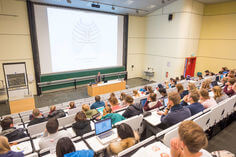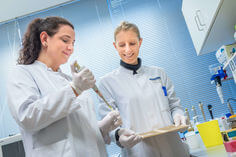Arbeitsgruppe Prof. Dr. Jan Siemens
Kontakt

Pharmakologisches Institut
Universität Heidelberg
Im Neuenheimer Feld 366
69120 Heidelberg
Tel. +49-(0)6221-548287
Fax +49-(0)6221-548367
E-Mail: jan.siemens(at)pharma.uni-heidelberg.de
Group leader in the Molecular Medicine Partnership Unit.
For more information on research interests, potential PhD and postdoctoral positions as well as current contact details please visit http://www.siemenslab.de/
Folge uns auf Twitter
Temperature Detection and Thermoregulation
The ability of any living organism to sense stimuli emanating from the surrounding environment is complemented by the ability to probe and detect inner parameters defining the internal state of the body (such as blood sugar levels, osmolarity, pH and others). Together, processing and integration of sensory information from the outside world and the internal environment – interoception – allows the organism to maintain homeostasis and adapt to outside stressors.
In our lab, we are particularly interested in temperature, a parameter that is modulating and affecting every aspect of live, at the organismic, tissue and cellular level, and down to every enzymatic reaction. Most, if not all, organisms can in some way sense temperature and react to it, which is critical for their survival – temperature detection likely represents one of the primordial senses developed very early on in the course of evolution. For the identification of key molecules detecting temperature by the nervous system, the TRP ion channels, David Julius and Ardem Patapoutian were awarded the Nobel Prize in 2021.
Internal temperature is tightly regulated in mammals, down to a few tenths of a degree Celsius, by controlling peripheral organs that mediate heat-gain and heat-loss. We are only beginning to understand the cellular mechanisms and circuits that govern and orchestrate thermal homeostasis. In all vertebrates the hypothalamus, and in particular the hypothalamic preoptic area (POA), is considered the main CNS hub: processing thermal information, integrating it with other internal state parameters, and regulating body temperature – from a reductive viewpoint, the POA is our biological “thermostat”.
Research Interests
We are interested in understanding how the preoptic “thermostat” operates, on the molecular, cellular and circuit level, and how it interacts with peripheral organs to accomplish thermal homeostasis. We have recently also become interested in studying thermal plasticity and the adaptation of the “thermostat” to long-lasting increases in environmental temperatures. Our data suggest that the POA has a primary role in establishing resilience to hot temperatures upon prolonged exposure to environmental heat, a phenomenon commonly known as acclimation or acclimatization. More generally, we are interested in assessing the therapeutic potential of the preoptic “thermostat”: the POA is connected to brain regions controlling energy expenditure and increasing body temperature – thermogenesis – requires burning of fuel. Thus, manipulating the preoptic “thermostat” could potentially be utilized to treat obesity.
In future research we are interested in an “evo-devo” type of approach – potentially using primordial model organism(s) – to study how internal temperature sensing and thermoregulation have evolved. We believe this research to expand our insight into generalizable physiological mechanisms governing thermoregulation and it may point to interactions with other homeostatic systems and unrecognized therapeutic potential.
ext to these main lines of interests we have focused interest also on related areas that, historically, were the starting point of our teams shift to temperature research:
- Human pluripotent stem cell-derived sensory neurons
- Peripheral temperature detection and pain signal processing
Scientists and aspiring scientists at the post graduate or undergraduate level interested in any of these research areas are more than welcome to contact Jan Siemens at jes(at)pharma.uni-heidelberg.de to explore the possibility of joining our team for an internship, a Master thesis, Doctoral thesis or Postdoctoral studies.
Human Pluripotent Stem Cell-Derived Sensory Neurons
Every day we experience a variety of sensations from our inner and outer environment that help shaping our behavior and wellbeing: shafts of sunlight that touch our skin can lift our spirits after a long cold winter, while a cool breeze can refresh us on a hot summer day. Responsible for our ability to detect these varied stimuli are somatosensory neurons that come in diverse subtypes, each specialized to detect and transduce specific sensory modalities. But besides detecting stimuli that are associated with a positive valence, these neurons are also indispensable to protect our integrity by detecting harmful insults, leading to pain that could result in tissue damage, if we do not react in an appropriate manner. Unfortunately, genetic mutations, certain diseases or traumata causing persistent tissue damage can perturb this warning and protecting system and causes pain to become permanent – a status almost every fifth person in the world is suffering from.
In the Siemens lab, we are interested in recapitulating sensory neuron development in vitro and attempt to generate homogenous populations of specific sensory neuron subtypes from human pluripotent stem cells (hESCS and hIPSCs). To this end, we developed various differentiation strategies based on a two-step process: in a first step we generate neural crest-like cells, the in vivo progenitors of sensory neurons. These cells have the capacity to differentiate further into sensory neurons, either by a growth factor driven approach or by virally induced forced expression of certain transcription factors.
The former results in the generation of large mechanoreceptor-like cells showing molecular and functional characteristics of low threshold mechanoreceptors, a sensory neuron subtype important for detecting touch and other low threshold mechanical stimuli. The latter results in the generation of functional sensory neurons showing characteristics of nociceptor-like cells such as expression of Nav1.8 and responsiveness to the TRPV1 agonist Capsaicin.
These cells serve as a tool to investigate specific aspects of sensory neurobiology in a human cell-based model system.
Our scientific aims are:
(i) Understanding developmental aspects of sensory neuron generation. We believe that this approach will yield new insight into sensory neuron differentiation that has escaped previous genetic studies using complex model organisms.
(ii) Investigating aspects of sensation in nociceptor-like cells and their synaptic transmission under normal and diseased conditions. Thereby we hope to find pathways that help to explain how normal sensitization can turn into chronic states. This project is supported by a collaborative research center funded by the German Research Foundation in collaboration with Claudio Acuna (group leader at Heidelberg University, funded by the Chica and Heinz Schaller Foundation).
Peripheral Temperature Detection And Pain Signal Processing
A number of molecular thermal sensors in the peripheral nervous system – largely belonging to the TRP ion channel family – have been described and were found to be essential for the sensation of painfully hot and cold temperatures. However, it is still unclear how more nuanced sensations of innocuous temperatures in the warm to coolish range are detected and whether the same molecules are working in concert to accomplish this or whether unidentified cellular mechanism bring about these sensations that, state-dependently, are sometimes perceived as pleasant and sometimes unpleasant. We are interested in uncovering (TRP-dependent and independent) mechanisms detecting and encoding “comfort temperature” and how they relate to body temperature regulation.
We also have become interested in somatosensory processing at the level of the spinal cord. In particular, a molecular-genetic screen has guided us to study energy-metabolic requirements that accompany spinal signal processing, in particular long-lasting and strong (chronic) pain signals. Our data suggest that spinal plasticity that results as a consequence of long-lasting/strong pain signals require energetic fuel that is provided by spinal glia cells. We are currently dissecting this energetic glia-neuro coupling and hope that (pharmacological) uncoupling could provide a therapeutic angel to counteract pain chronicity.
Mitarbeiterinnen und Mitarbeiter
| Name | Position | Raum | Tel.: | |
|---|---|---|---|---|
| +49 (0)6221-54- | ||||
| Antonio, Jessica | Ph.D. student | 304 | 8246 | |
| Bellotto Werlang, Jessica | Ph.D. student | 325 | 4901 | |
| Bertone Arolfo, Matias | Ph.D. student | 304 | 8246 | |
| Bouaouda, Hanan | Post Doc | 304 | 8246 | |
| Cavaroc, Amandine | Technician | 324 | 4901 | |
| Lukasova, Martina | Pharmazeutin | 324 | 8288 | |
| Montanari, Roberto | Post Doc | 303 | 8246 | |
| Panayotova, Maria | Ph.D. student | 303 | 8288 | |
| Peng, Dangsheng | Ph.D. student | 324 | 4901 | |
| Peshcherova, Daria | Administrative Officer | 303 | 8288 | |
| Pontearso, Monica | Post Doc | 304 | 8246 | |
| Schrenk-Siemens, Katrin | Dr. rer. nat. | 303 | 8288 | |
| Siegmund, Christine | Technician | 324 | 4901 | |
| Siemens, Jan | Prof. Dr. | 302 | 8287 | |
| Wang, Jialin | Ph.D. student | 304 | 8246 |
Publikationen
Peer Reviewed Publications and Preprint Publications (bioRxiv)
Thermally induced neuronal plasticity in the hypothalamus mediates heat tolerance. Wojciech Ambroziak, Sara Nencini, Jörg Pohle, Kristina Zuza, Gabriela Pino, Sofia Lundh, Carolina Araujo-Sousa, Larissa I. L. Goetz, Katrin Schrenk-Siemens, Gokul Manoj, Mildred A. Herrera, Claudio Acuna & Jan Siemens. 2024, Nature Neuroscience, Dec 9. doi: 10.1038/s41593-024-01830-0
An Intra-Hypothalamic Pathway Modulating Body Temperature and Feeding. Sara Nencini & Jan Siemens. 2024, bioRxiv, Apr 16. doi: 10.1101/2024.04.16.589686
Neuron–astrocyte metabolic coupling facilitates spinal plasticity and maintenance of inflammatory pain. Sebastián Marty-Lombardi, Shiying Lu, Wojciech Ambroziak, Katrin Schrenk-Siemens, Jialin Wang, Anna A. DePaoli-Roach, Anna M. Hagenston, Hagen Wende, Anke Tappe-Theodor, Manuela Simonetti, Hilmar Bading, Jürgen G. Okun, Rohini Kuner, Thomas Fleming & Jan Siemens. 2024, Nature Metabolism, Mar 05. doi: 10.1038/s42255-024-01001-2
Diverging roles of TRPV1 and TRPM2 in warm-temperature detection. Muad Y. Abd El Hay, Gretel B. Kamm, Alejandro Tlaie & Jan Siemens. 2024, eLife 13:RP95618, Mar 05. doi: 10.7554/eLife.95618.1
Human Stem Cell-Derived TRPV1-Positive Sensory Neurons: A New Tool to Study Mechanisms of Sensitization. Katrin Schrenk-Siemens, Jörg Pohle, Charlotte Rostock, Muad Abd El Hay, Ruby M. Lam, Marcin Szczot, Shiying Lu, Alexander T. Chesler & Jan Siemens. 2022, Cells, 11(18): 2905, Sep 17. doi: 10.3390/cells11182905
A synaptic temperature sensor for body cooling. Gretel B. Kamm, Juan C. Boffi, Kristina Zuza, Sara Nencini, Joaquin Campos, Katrin Schrenk-Siemens, Ivo Sonntag, Burçe Kabaglou, Muad Y. Abd El Hay, Yvonne Schwarz, Anke Tappe-Theodor, Dieter Bruns, Claudio Acuna, Thomas Kuner & Jan Siemens. 2021 Neuron; 109: 3283-3297.e11. doi: 10.1016/j.neuron.2021.10.001
Astrocytes mediate the effect of oxytocin in the central amygdala on neuronal activity and affective states in rodents. Wahis et al. 2021, Nature Neuroscience; 24: 529-541. doi: 10.1038/s41593-021-00800-0
HESC-derived sensory neurons reveal an unexpected role for PIEZO2 in nociceptor mechanotrans duction. Katrin Schrenk-Siemens, Jörg Pohle, Charlotte Rostock, Muad Abd El Hay, Ruby M. Lam, Marcin Szczot, Shiying Lu, Alexander T. Chesler & Jan Siemens. 2019, bioRxiv, Aug 23. doi: 10.1101/741660
Human vs. Mouse Nociceptors - Similarities and Differences. Charlotte Rostock, Katrin Schrenk-Siemens, Jörg Pohle and Jan Siemens. 2018, Neuroscience, 387, 13-27
Regulation of body weight and energy homeostasis by neuronal cell adhesion molecule 1. Thomas Rathjen, Xin Yan, Natalia Kononenko, Min-Chi Ku, Kun Song, Leiron Ferrarese, Valentina Tarallo, Dmytro Puchkov, Gaga Kochlamazashvili, Sebastian Brachs, Luis Varela, Klara Szigeti-Buck, Chun-Xia Yi, Sonia C. Schriever, Sudhir Gopal Tattikota, Anne Sophie Carlo, Mirko Moroni, Jan Siemens, Arnd Heuser, Louise van der Weyden, Andreas L. Birkenfeld, Thoralf Niendorf, James F. Poulet, Tamas L. Horvath, Matthias H. Tschöp, Matthias Heinig, Mirko Trajkovski, Volker Haucke, and Matthew N. Poy. 2017, Nature Neuroscience, 20, 1096-1103
The TRPM2 channel is a hypothalamic heat sensor that limits fever and can drive hypothermia.Kun Song, Hong Wang, Gretel B Kamm, Jörg Pohle Fernanda C. Reis, Paul Heppenstall, Hagen Wende and Jan Siemens. 2016, Science, 353, 1393-1398
GABA Blocks Pathological but Not Acute TRPV1 Pain Signals.Christina Hanack, Mirko Moroni, Wanessa Lima, Hagen Wende, Marieluise Kirchner, Lisa Adelfinger, Katrin Schrenk-Siemens, Anke Tappe-Theodor, Christiane Wetzel, Henning Kuich, Martin Gassmann, Dennis Roggenkamp, Bernhard Bettler, Gary R. Lewin, Matthias Selbach & Jan Siemens. 2015, Cell, 160, 759–770
PIEZO2 is required for mechanotransduction in human stem cell-derived touch receptors. Katrin Schrenk-Siemens, Hagen Wende, Vincenzo Prato, Kun Song, Charlotte Rostock, Alexander Loewer, Jochen Utikal, Gary Lewin Stefan Lechner & Jan Siemens. 2015, Nature Neuroscience, 18, 10–16
A somatosensory circuit for cooling perception in mice. Nevena Milenkovic,Wen-Jie Zhao, Jan Walcher, Tobias Albert, Jan Siemens, Gary Lewin & James Poulet. 2014, Nature Neuroscience, 17, 1560–1566
Proteolytic processing of the protein tyrosine phosphatase alpha extracellular domain is mediated by ADAM17/TACE. Katja Kapp*, Jan Siemens*, Hans-Ulrich Häring, Reiner Lammers. 2012, Eur J Cell Biol, 91, 687-693. *denotes equal contribution
A Bivalent Tarantula Toxin Reveals a Unique Role for the Outer Pore Domain in TRP Channel Gating. Christopher J. Bohlen, Avi Priel, Sharleen Zhou, David King, Jan Siemens*, and David Julius*. 2010, Cell, 141, 834-845. *Co-Corresponding Authors
4-Hydroxynonenal, an Endogenous Aldehyde, causes Pain and Neurogenic Inflammation through Activation of the Irritant Receptor, TRPA1. Marcello Trevisani*, Jan Siemens*, Serena Materazzi, Diana M. Bautista, Romina Nassini, Barbara Campi, Noritaka Imamachi, Eunice Andrè, Riccardo Patacchini, Graeme. S. Cottrell, Raffaele Gatti, Allan I. Basbaum, Nigel W. Bunnett, David Julius and Pierangelo Geppetti. 2007, PNAS, 104, 13519-13524. *denotes equal contribution
TRPA1 mediates Formalin Induced Pain. Colleen R. McNamara, Josh Mandel-Brehm, Diana M. Bautista, Jan Siemens, Kari L. Deranian, Michael Zhao, Neil J. Hayward, Jayhong A. Chong, David Julius, Magdalene M. Moran, and Christopher M. Fanger. 2007, PNAS, 104, 13525-13530
The Menthol Receptor TRPM8 is the Principal Detector of Environmental Cold. Diana M. Bautista*, Jan Siemens*, Josh Glazer, Pamela R. Tsuruda, Allan I. Basbaum, Cheryl L. Stucky, Sven-Eric Jordt, and David Julius. 2007, Nature, 448, 204-208. *denotes equal contribution
Extracellular Domain Splice Variants of a Transforming Protein Tyrosine Phosphatase alpha mutant differentially activate Src-kinase dependent Focus Formation. Katja Kapp*, Jan Siemens*, Peter Weyrich, Jörg B. Schulz, Hans-Ulrich Häring, Reiner Lammers. 2007, Genes to Cells, 12, 63-73. *denotes equal contribution
Spider Toxins activate the Capsaicin Receptor to produce Inflammatory Pain. Jan Siemens, Sharleen Zhou, Rebecca Piskorowski, Tetsuro Nikai, Ellen A. Lumpkin, Allan I. Basbaum, David King, David Julius. 2006, Nature, 444, 208-212
Cadherin 23 is a Component of the Tip Link in Hair Cell Stereocilia. Jan Siemens, Concepcion Lillo, Rachel A. Dumont, David Williams, Peter Gillespie, and Ulrich Müller. 2004, Nature, 428, 950-955
Mutations in Cadherin 23 affect Tip Links in Zebrafish Sensory Hair Cells. Christian Söllner, Gerd-Jörg Rauch, Jan Siemens, Robert Geisler, Stephan C. Schuster, the Tübingen 2000 Screen Consortium, Ulrich Müller, & Teresa Nicolson. 2004, Nature, 428, 955-959
The Usher Syndrome Proteins Cadherin 23 and Harmonin form a Complex by means of PDZ Domain Interactions. Jan Siemens, Piotr Kazmierczak, Anna Reynolds, Melanie Sticker, Amanda Littlewood-Evans, and Ulrich Mueller. 2002, PNAS, 99, 14946-14951
Review Publications and Book Chapters
Neuroscience: Detection of systemic inflammation by the brain. Gretel B. Kamm, Jan Siemens. 2022, Current Biology, 32: R736-R755, July 11. doi: 19.1016/j.cub.2922.05.028
TRPM4 keeps up the pace. Wojciech Ambroziak, Jan Siemens. 2021, Cell Calcium, 96: 102401
Cellular populations and thermosensing mechanisms of the hypothalamic thermoregulatory center. Jan Siemens, Gretel B. Kamm. 2018, Pflugers Arch, 470: 809-822
The TRPM2 channel in temperature detection and thermoregulation. Gretel B. Kamm and Jan Siemens. 2016, Temperature, 4(1): 21-23. doi: 10.1080/23328940.2016.1258445
TRP ion channels in thermosensation, thermoregulation and metabolism. Hong Wang and Jan Siemens. 2015, Temperature, 2: 178-187
Modulation of TRP ion channels by venomous toxins. Jan Siemens and Christina Hanack. 2014, Handb Exp Pharmacol, 223: 1119-1142
Sensory transduction, the gateway to perception: mechanisms and pathology. Stefan Lechner, Jan Siemens. 2011, Embo Reports, 12: 292-295
Genes, Deafness, and Balance Disorders. Jan Siemens, Amanda Littlewood-Evans, Mathias Senften, and Ulrich Mueller. 2001, Gene Function & Disease, 2: 76-82
The Sound of Silence - Diseases that cause Deafness and Disequilibrium. Jan Siemens, Amanda Littlewood-Evans, and Ulrich Mueller. 2001, B.I.F. Futura, 16: 222-228




